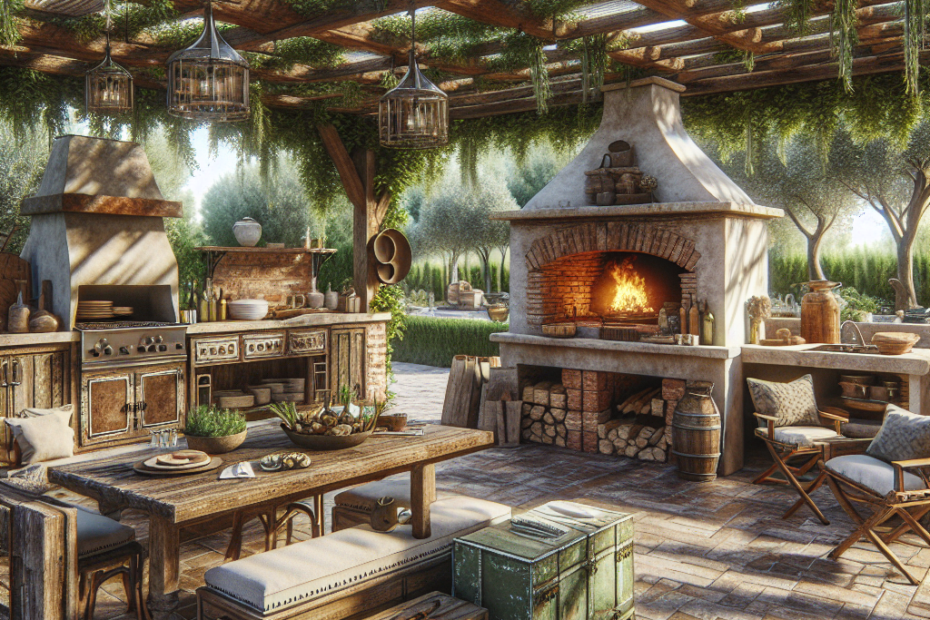The Essentials of Rustic Outdoor Kitchens
When considering ways to enhance their outdoor spaces, homeowners frequently think about integrating aspects that bring coziness and functionality. A popular trend today is the installation of rustic outdoor kitchens. These kitchens not only serve as a focal point for outdoor gatherings but also increase the property’s value. In exploring rustic outdoor kitchen design, certain essentials must be considered to create a perfect blend of nature and culinary warmth.
Understanding Rustic Outdoor Kitchen Design
Rustic outdoor kitchens are crafted to capture the charm and simplicity of rural life. They focus on using natural materials like wood, stone, and metal to create a welcoming atmosphere that’s both functional and aesthetically pleasing. The rustic design evokes a sense of nostalgia, making people feel as though they are dining in the countryside, even if they are just steps from their urban home.
According to a 2023 Real Estate Design Trends report, homes equipped with outdoor kitchens see up to a 70% return on investment (source: Home Design Statistics 2023). People are increasingly drawn to designs that incorporate traditional elements with modern convenience.
Essential Components of Rustic Outdoor Kitchens
1. Natural Materials
The hallmark of a rustic outdoor kitchen is the use of organic materials. Wood is frequently used for cabinetry and furniture, offering a warm and inviting feel. Stone countertops are popular due to their durability and rustic aesthetic. Metal accents, like wrought iron, add to the countryside charm.
2. Cozy Seating Arrangements
A well-designed rustic outdoor kitchen includes cozy seating that encourages relaxation. Weather-resistant cushions made from natural fibers like cotton or linen enhance comfort while contributing to the rustic theme. Incorporating a large table for family-style dining fosters an environment that is perfect for gatherings.
3. Functional Cooking Appliances
While the rustic design emphasizes simplicity, it never compromises on functionality. Cooking appliances such as grills and brick ovens are essential. These not only serve practical purposes but also contribute to the rustic aesthetic. The goal is to balance technological advancements with the timeless rustic look.
4. Ambient Lighting
Lighting is crucial in setting the ambiance. Using warm, soft lights such as lanterns or string lights helps evoke a romantic rural atmosphere. Such lighting not only adds to the charm but also ensures functional benefits during late evening cookouts.
5. Weather-Protected Features
A rustic outdoor kitchen must be able to withstand the elements. Properly sealing wood and choosing rust-resistant metals are essential for durability. Additionally, incorporating sheltering elements like pergolas and awnings can protect both the kitchen and its users from harsh weather conditions.
Statistics to Consider
| Feature | Potential ROI Increase (%) | Source |
|---|---|---|
| Outdoor Kitchens | 70 | Home Design Statistics 2023 |
| Natural Materials Usage | 60 | Design Trends Study 2023 |
| Eco-Friendly Appliances | 40 | Sustainable Living Report 2023 |
Integrating Personal Touches
Every rustic outdoor kitchen should reflect the personality of its owners. Personal touches such as vintage decor, family heirlooms, or collections of themed dinnerware can make the space uniquely theirs. Encouragingly, homeowners have plenty of space to express their personal style while keeping the design cohesive.
Key Takeaways
- Rustic outdoor kitchens combine natural materials with functional design, offering both charm and practicality.
- Key elements include cozy seating, functional appliances, and ambient lighting.
- Investing in such a kitchen can offer a significant return on investment, up to 70% according to recent statistics.
- Personal touches are important to ensure the kitchen reflects the owner’s taste.
FAQs
Q1: What are the benefits of a rustic outdoor kitchen?
A: Rustic outdoor kitchens provide a charming and functional gathering space, enhance the property’s value, and offer an excellent return on investment.
Q2: What materials are best for a rustic outdoor kitchen?
A: Natural materials such as wood, stone, and metal are ideal. These materials help provide the rustic charm and durability needed for outdoor conditions.
Q3: How can I protect my outdoor kitchen from weather damage?
A: Use weather-resistant materials, apply sealants to wood, and include structures like pergolas or awnings to provide shelter.
Q4: Which appliances are a must-have in a rustic outdoor kitchen?
A: Essential appliances include a grill or brick oven, which align with the rustic theme while providing cooking functionality.
Q5: How can I personalize my rustic outdoor kitchen design?
A: Add personal touches through decor, such as vintage pieces, themed dinnerware, or family heirlooms, to make the space uniquely yours.
